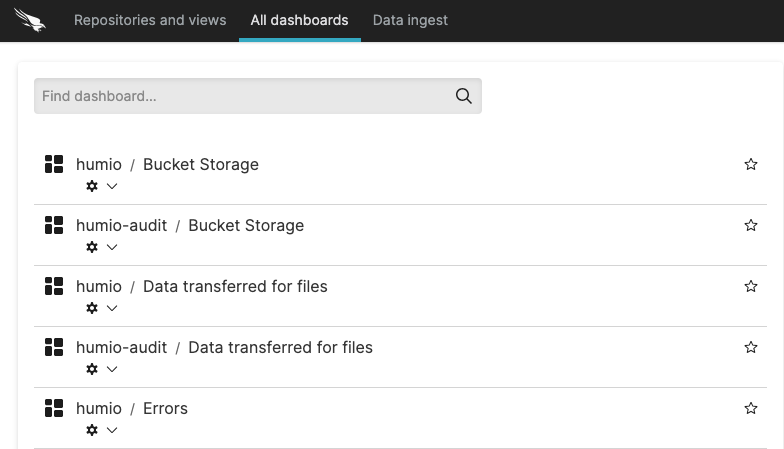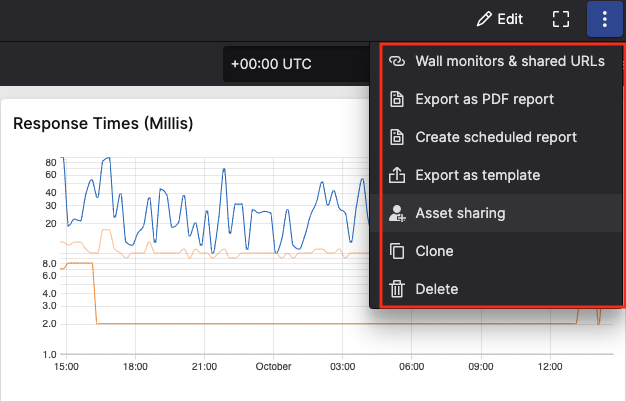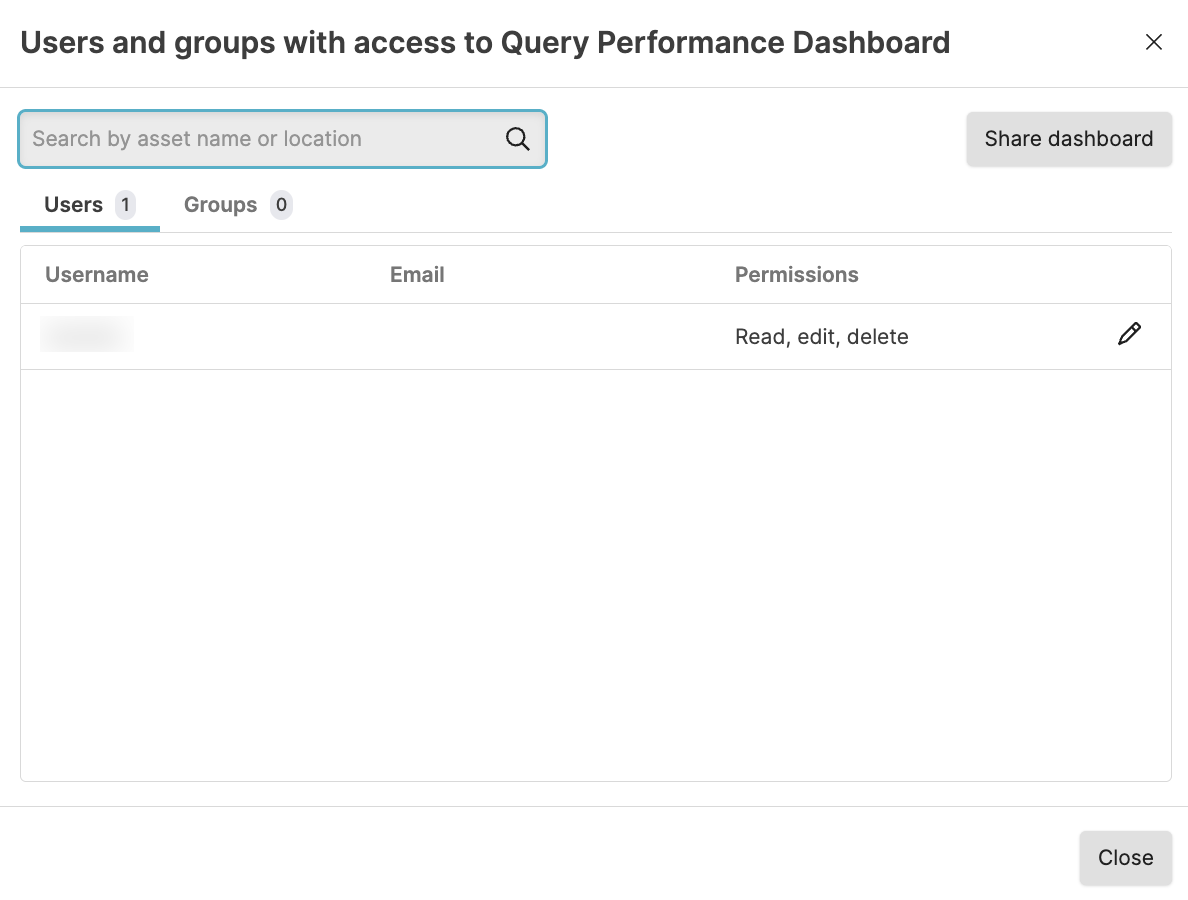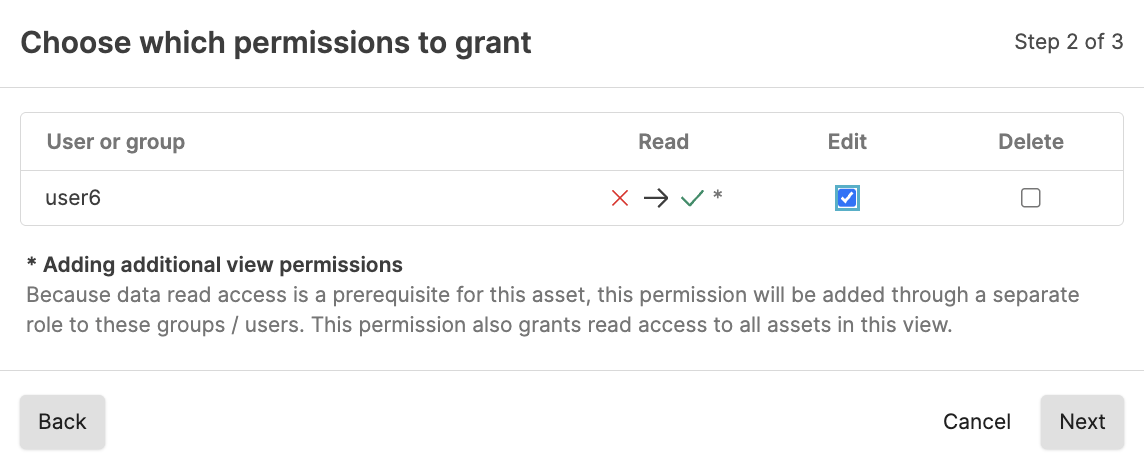Manage Dashboards
Security Requirements and Controls
Data read accesspermissionUpdate dashboardspermission
When accessing an existing dashboard within your LogScale instance, you can choose to navigate around the dashboard view, share, export or duplicate the dashboard, and configure the dashboard access.
Access all dashboards across repositories
Security Requirements and Controls
Data read accesspermission
The All Dashboards system tab displays all dashboards from all repositories and views.
In the system tabs' main toolbar, click :

Figure 153. Access all dashboards
Select the desired dashboard by clicking the title after the slash: the dashboard and all its widgets will load (clicking the first item instead redirects you to the
Searchinterface in that repository).Optionally, click the star icon next to a dashboard to save it as favorite and bring it on top of the list for quicker access.
Optionally, click the gear icon to perform several operations on the dashboard such as sharing, exporting or deleting the dashboard — see Manage individual dashboards for details.
Note
Verify your permissions before accessing existing dashboards. Access to dashboards requires permissions to their associated repositories and views.
Manage repository dashboards
Security Requirements and Controls
Data read accesspermission
The Dashboards Interface presents all dashboards that belong to a given repository in a table component format.
The table provides several options to manage repository dashboards, as follows.
You can manage multiple dashboards and perform bulk actions without opening dashboards one by one. Check the checkboxes → click to either:
the selected dashboards
to the selected dashboards
the dashboards as .zip file

Figure 154. Repository dashboards
You can perform more actions on a specific dashboard directly from the table without opening the dashboard. Click the ⋮ menu icon next to a dashboard:

Figure 155. Repository dashboards
deletes the dashboard from the list
exports the dashboard as a yaml file
creates a copy of the dashboard, which can be saved in this or in another repository.
allows for setting permissions for that dashboard, see Permissions for dashboards for more information.
You can customize the style and formatting of a specific dashboard directly from the overview table without opening the dashboard. To do so, click on a dashboard row to open the Properties panel on the side:

Figure 156. Customize dashboards from the overview table
In the panel, you can modify:
Name and description
Labels
Colors
Default time
Series formatting
These settings are also available in the dashboard edit panel, see Customize Dashboards for a detailed description.
Manage individual dashboards
Security Requirements and Controls
Delete Dashboardspermission
After you open a dashboard, you can manage it using the controls highlighted in Figure 157, “Manage Dashboards”:
 |
Figure 157. Manage Dashboards
Edit icon — enables the dashboard editing mode, see Customize Dashboards.
full screen icon — expands the dashboard to fill the screen
⋮ menu icon — provides access to several operations that you can perform on an individual dashboard:

Figure 158. Dashboard operations
Available operations from the menu icon are:
— allows to share read-only dashboards. See Share Dashboards section below for more details.
— allows you to export the dashboard in PDF with several print options such as add the dashboard title in the header or the time window it was executed, set it as portrait or landscape, etc.
For more information, see Export Dashboards as PDF.
— allows you to export the dashboard in PDF with several print options such as add the dashboard title in the header or the time window it was executed, set it as portrait or landscape, etc.
For more information, see Schedule PDF Reports.
— allows you to create a template from the current dashboard, which you may reuse for new empty dashboards, as explained in Create Dashboards.
— allows you to give access to read, edit, or delete dashboards to another user or group.
For more information, see Permissions for dashboards.
— creates an identical dashboard. You are prompted to provide:
Dashboard name is the name you assign to the copied dashboard.
Target repository or view is the repository or view where you want to store your copied dashboard.
— deletes the dashboard and all associated widgets. Removal of a dashboard cannot be undone. To create a backup of the dashboard, consider using the option to keep a copy of the dashboard and its configuration.
Permissions for dashboards
Security Requirements and Controls
Change user accesspermission
Sometimes you might want to collaborate with another user on a dashboard, but that user does not have permission to dashboards in the view. If you have permissions to do so, you can grant permissions to that user to edit and delete a particular dashboard in a view. For more information about asset permissions, see Asset permissions.
If you do not have
Change user access
permission on the repository, you will see a list of users only (no
groups) that already have at least Read permissions on the repository.
You can select from these users and give them more permissions (up to
the same permissions you have).
To grant access to edit or delete a dashboard to another user or group:






